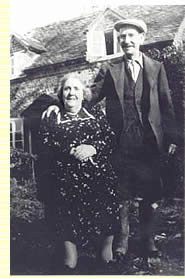If – in a folk song at least – you ride /walk / roam / rove out on a May morning, you are guaranteed to meet a member of the opposite sex. That encounter may lead to a bit of rumpy-pumpy, maybe even true love; but it might have darker consequences.
Exactly what’s going on in this version isn’t clear: who is the woman that George Collins meets? how does she know he’s going to die? and what does he die of? But none of those things really matters – they just add to the song’s wonderfully mysterious air. And in any case, what is clear from the final verse is that George was a bit of a ladies’ man, a pin-up perhaps, news of whose death leads to six pretty maids dying of a broken heart.
Actually, ballad scholars do have a pretty good idea of how this story started out. In his notes to the Penguin Book of English Folk Songs, A L Lloyd wrote:
The plot of George Collins has its secrets. From an examination of a number of variants, the full story becomes clearer. The girl by the stream is a water-fairy. The young man has been in the habit of visiting her. He is about to marry a mortal, and the fairy takes her revenge with a poisoned kiss. The song telling that story is among the great ballads of Europe. Its roots and branches are spread in Scandinavia, Germany, France, Italy, Spain and elsewhere. An early literary form is the German poem of the Knight of Staufenberg (c. 1310). France alone has about ninety versions, mostly in the form of the familiar Le Roi Renaud, though here much of the dream-quality of the tale is missing, since the girl by the stream is lost sight of, and instead the hero is mortally wounded in battle. The first half of the George Collins story is told in the ballad called Clerk Colvill (Child 42), the second half in Lady Alice (Child 85). Either these are two separate songs which have been combined to form George Collins or (which seems more likely) they are two fragments of the completer ballad. George Collins has rarely been reported in England, though in the summer of 1906 Dr. G. B. Gardiner collected three separate versions in different Hampshire villages, two of them on the same day. (FSJ vol.III, pp.299-301)
N.B. I’ve copied that chunk of text from a post by Malcolm Douglas – who edited Classic English Folk Songs, the revised EFDSS reprint of the Penguin Book – on Mudcat. That discussion also contains some interesting American variants. One starts
‘Twas at a western water tank
One cold December day
And in an empty boxcar
A dying hobo lay
but then recognisably becomes a version of ‘George Collins’ in the second verse
You see his girl in yonders hall
A-sewing her silk so fine
But when she heard poor George was dead
She laid her silks aside
The versions collected by Gardiner in Hampshire – the source of the composite version in the Penguin volume – can be found on the EFDSS Take Six website.
This version, however, was collected – also in Hampshire – by Bob Copper in the 1950s from Enos White of Axford. I think I first heard it performed by Shirley and Dolly Collins on the LP The Sweet Primeroses, but learned the song from Bob’s book Songs and Southern Breezes. Enos White’s performance can be heard on O’er His Grave the Grass Grew Green (The Voice of the People Volume 3), while you can hear Bob himself singing it on the Veteran CD When the May is all in bloom.
George Collins

